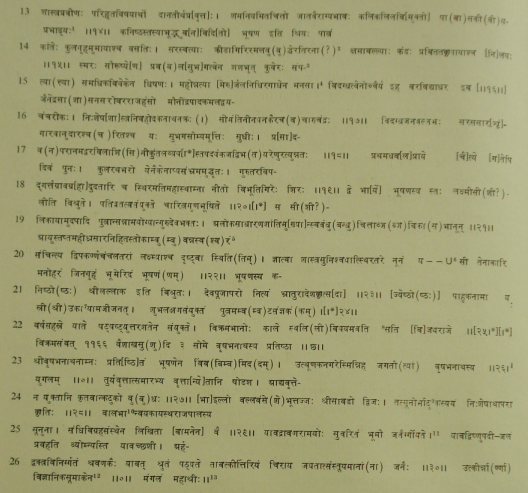| |
North
Indian Inscriptions |
| |
|
|
|
INSCRIPTIONS OF THE PARAMARAS OF VAGADA

_______________________________________________________________
[1] Probably here the poet intended to use प्रभावाढ्यः which would not suit the metre.
[2 There appear some scratching and over-writing on this and the preceding two letters, making the reading indistinct. Probably –रतिशयः may been intended.
[3] There are two redundant daṇḍas as the end of this line.
[4] There is a redundant stroke here.
[5] The sign of anusvāra, as also others below, is represented by a hollow circle marked not over but in continuation of the letter to which it belongs.
[6] These four aksharas are totally mutilated and the space occupied by them shows that one more akshara may have originally been at first engraved and deleted later on. Probably what appears to have been engraved is यशःश्रेयसी,
[7] The reading of the first letter of the name is uncertain: it may be सीउका also, as read by Halder.
[8] Taking the second letter of this foot short, as engraved here, it would have 17 mātrās instead of 18, as required. The name was स्थली and not स्थलि, which is used for the metre.
[9] This akshara can also be read as दु.
[10] This letter is mutilated and looks like मा but is restored here in view of the appears of the word in the preceding record.
[11] The daṇḍa is redundant, Moreover, it is strange to note how Rāvaṇa’s behaviour is called good here.
[12] Halder read the name as स्तमकः, but to me what he took to be त appears to be a mātrā, उत्कीर्ण्णा is in feminine as an adjective of kīrtti, meaning praśasti,
[13] This is followed by a floral design and a symbol resembling chha, between a double daṇḍa, as also the first syllable in the next line.
...................CORPUS INSCRIPTIONUM INDICARUM
VOL.VII ........................................................................PLATE XXVII
ARTHUNA STONE INSCRIPTION OF THE TIME OF VIJAYARAJA: (VIKRAMA) YEAR 1166

|
\D7
![]()
|









